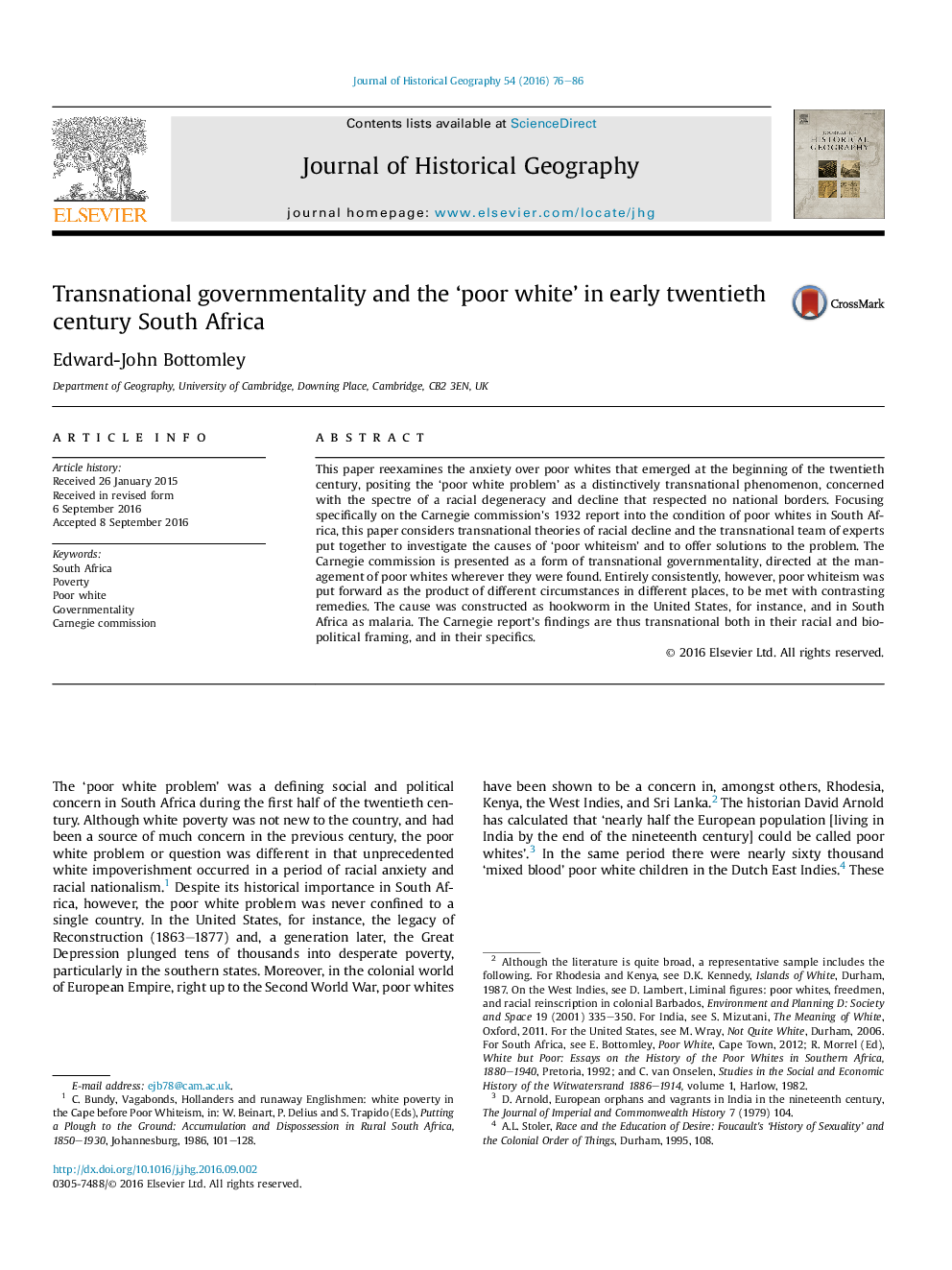| کد مقاله | کد نشریه | سال انتشار | مقاله انگلیسی | نسخه تمام متن |
|---|---|---|---|---|
| 7447206 | 1483971 | 2016 | 11 صفحه PDF | دانلود رایگان |
عنوان انگلیسی مقاله ISI
Transnational governmentality and the 'poor white' in early twentieth century South Africa
ترجمه فارسی عنوان
حکومت بین المللی و "سفید ضعیف" در اوایل قرن بیستم آفریقای جنوبی
دانلود مقاله + سفارش ترجمه
دانلود مقاله ISI انگلیسی
رایگان برای ایرانیان
کلمات کلیدی
آفریقای جنوبی، فقر، ضعیف سفید حکومتداری، کمیسیون کارنگی،
ترجمه چکیده
این مقاله اضطراب را در مورد سفید پوستان که در اوایل قرن بیستم ظهور کرده بود، دوباره مورد بررسی قرار می دهد و «مشکل سفید پوستان» را به عنوان یک پدیده بین المللی مشخص می کند، که با نزاع و جدال نژادی و زوال است که مرزهای ملی را احترام نمی گذارد. این مقاله به طور خاص در گزارش کمیسیون کارنگی در سال 1932 به شرایط سفید پوستان فقیر آفریقای جنوبی متمرکز است. در این مقاله، نظریه های فراملیتی از کاهش نژادی و تیم ملی فراملی متخصصان برای بررسی علل سفید پوستان سفید پوست و ارائه راه حل هایی برای این مشکل در نظر گرفته شده است. . کمیسیون کارنگی به عنوان یک شکل از حکومت بین المللی، که در زمینه مدیریت سفیدپوستان فقیر در هر کجا یافت می شود، ارائه می شود. با این حال، به طور مداوم، سفیدپوستان ضعیف به عنوان محصول شرایط مختلف در مکان های مختلف مطرح شد، که با روش های متضاد ملاقات شده بود. این علت به عنوان مثال در ایالات متحده به عنوان کرم قلابی ساخته شده است و در آفریقای جنوبی به عنوان مالاریا شناخته شده است. یافته های گزارش کارنگی به این ترتیب فراملیتی است که هر دو در فریم های نژادی و بیوپولتیک خود، و در مشخصات خود دارند.
موضوعات مرتبط
علوم انسانی و اجتماعی
علوم انسانی و هنر
تاریخ
چکیده انگلیسی
This paper reexamines the anxiety over poor whites that emerged at the beginning of the twentieth century, positing the 'poor white problem' as a distinctively transnational phenomenon, concerned with the spectre of a racial degeneracy and decline that respected no national borders. Focusing specifically on the Carnegie commission's 1932 report into the condition of poor whites in South Africa, this paper considers transnational theories of racial decline and the transnational team of experts put together to investigate the causes of 'poor whiteism' and to offer solutions to the problem. The Carnegie commission is presented as a form of transnational governmentality, directed at the management of poor whites wherever they were found. Entirely consistently, however, poor whiteism was put forward as the product of different circumstances in different places, to be met with contrasting remedies. The cause was constructed as hookworm in the United States, for instance, and in South Africa as malaria. The Carnegie report's findings are thus transnational both in their racial and biopolitical framing, and in their specifics.
ناشر
Database: Elsevier - ScienceDirect (ساینس دایرکت)
Journal: Journal of Historical Geography - Volume 54, October 2016, Pages 76-86
Journal: Journal of Historical Geography - Volume 54, October 2016, Pages 76-86
نویسندگان
Edward-John Bottomley,
